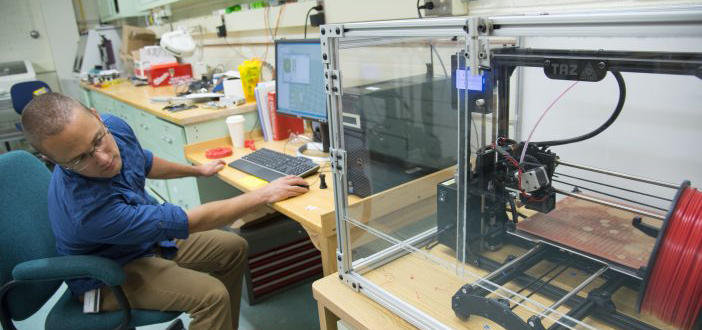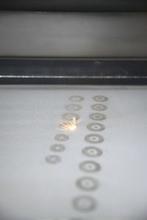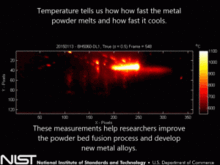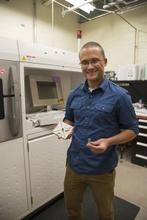Manufacturing Innovation Blog
Powered by the Manufacturing Extension Partnership

This article originally appeared on the NIST Taking Measure blog. Guest blog post by Jarred Heigel.
I research additive manufacturing, which some people call solid freeform fabrication, but most people know as 3-D printing. Additive manufacturing covers a wide range of processes that we can use to build parts and whole structures by strategically adding material only where we need it.

In the NIST Engineering Laboratory, of which I am a proud member of the Production Systems Group, we study the 3-D printing processes, such as Powder Bed Fusion (PBF) and Directed Energy Deposition (DED), used to build metal parts. PBF uses an energy beam (either laser or electron) to melt thin layers of powdered metal that are incrementally spread across a build surface (bed). When the part is completed, you have to excavate it from the powder bed like a dinosaur skeleton at an archeological dig.
DED also uses an energy beam to melt the metal, but instead of melting powder that has already been spread across the bed, metal in the form of powder or wire is fed into the beam, where it melts and fuses with previously deposited material. Unlike PBF, we can use DED to repair existing worn parts. We can also efficiently create a new part by first producing much of a part with conventional processes, such as casting or machining, then using DED to add only the necessary remaining features, such as an ultralightweight bracket or a fluid passage.

Why do temperature fluctuations lead to failures? Well, you probably know that most materials expand when they heat up and contract as they cool. The localized heating we’re talking about occurs at rates of up to 1,000,000 degrees Celsius per second as the molten metal is fused to the part.
As you might imagine, this would cause just about anything to get out of whack.
Many of the current challenges with metal additive manufacturing can be solved through a better understanding of the materials and the process — and that means measurements. This is where my group comes into the picture. We are currently using a wide range of techniques, including thermal imaging, to learn about the process and to develop new measurement techniques needed by users of additive manufacturing systems.

What’s exciting to me is that additive manufacturing systems can lead people down a path of scientific discovery. To create more accurate parts, you have to study your build to understand where the problem arose, research what others have done to solve similar problems, hypothesize and test possible solutions, and finally implement your fix. Working to solve these kinds of problems exposes you to fields as diverse as mathematics, heat transfer, material science, mechatronics, and programming — and could perhaps ignite a life-long interest.
Additive manufacturing, and manufacturing in general, is a great example of interdisciplinary research. No matter your interest, your innovations can potentially lead to processing advancements that enable the production of better prosthetics and biological implants, aircraft components, or even the hardware necessary to explore Mars and other extraterrestrial destinations. Therefore, it ultimately doesn’t matter what you call these technologies that can make complex components out of exotic materials or can be used by individuals at home. They’re exciting regardless of the name.
Featured Image Photo Credit: F. Webber/NIST
About the author
Related Posts
Comments
- Reply

